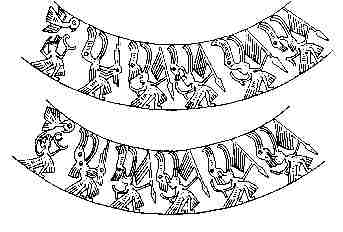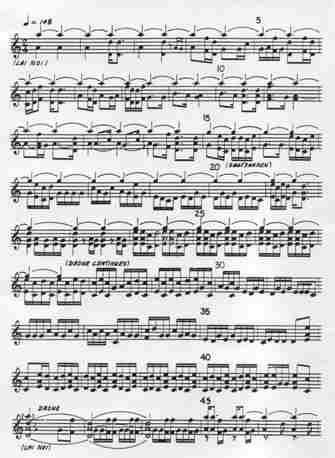| The Classical Free-Reed, Inc. History of the Free-Reed Instruments in Classical Music |
|
Asian Free-Reed Instruments by Henry Doktorski (© 2000) |
| Part Three: The Laotian Khaen |

|
Illustration 16: The Khaen. Photo by Randy Raine-Reusch |
| The Classical Free-Reed, Inc. History of the Free-Reed Instruments in Classical Music |
|
Asian Free-Reed Instruments by Henry Doktorski (© 2000) |
| Part Three: The Laotian Khaen |

|
Illustration 16: The Khaen. Photo by Randy Raine-Reusch |
The eighteen-pipe version, the khaen gao, that reached six feet and more in length, is rarely seen today.
Playing such an instrument was extremely taxing on account of the large amount of wind the players had to provide
with their breath. In addition, the instrument was difficult to transport. Prince Henri d'Orleans wrote in 1894,
"A man carrying a Laotian organ, which he has difficulty in setting up, follows them [the singers]. The pipes of
the organ are so long -- nearly fourteen feet -- that he is finally obliged to cut a hole in the roof, but the
damage can be easily repaired."
(End note 15)
Some khaen measuring three meters long can be seen at the National Museum in Bangkok.
Khaen reeds are made from an alloy of copper and silver and are fitted into the pipe walls
inside the hardwood wind chest. The traditional manner of making reeds is
to hammer a small coin on a wooden anvil until it is paper thin and cut it to size on a cutting board made from an
elephant thighbone. The pipes are sealed into the wind chest with a black
substance similar to beeswax called kisoot, a waste-product from the soot insect. Players
also pinch off a small piece of kisoot to stop the drone pipes.
(End note 16)
Terry E. Miller,
The Garland Encyclopedia of World Music, Volume 4: Southeast Asia,
(New York: Garland Publishing, 1998), 348.
The early history of the khaen is unknown, as there are few written records, due to several reasons:
2) Various armies from time to time have destroyed entire cities and their treasures.
(End note 17)
3) The Lao lack elaborate tombs such as the Chinese, which preserved not only bodies of famous people but also their
artifacts, such as musical instruments.
Transcription by Terry E. Miller. From Terry E. Miller, Traditional Music of the Lao: Kaen Playing
and Mawlum Singing in Northeast Thailand (Westport, Connecticut: Greenwood Press,
1985), 242.
The complex note arrangements of the
khaen allow a good performer to play a melody (usually in the lower voice) simultaneously with chord sonorities and one
or two drones above. Most players have no "formal"
music instruction and the music they play is nearly always
improvised. Serious players, however, can improve their technique by visiting khaen masters. Many schools and
universities offer lessons in khaen, although their students do not learn how to improvise; they learn popular
tunes and short compositions in traditional dance style.
In the past, the khaen was used in performances of Lao court music, which was similar to Siamese court music.
Instruments of the ensemble were the ranat (xylophone), kawng wong (bronze gongs mounted on a
circular wood frame), saw (fiddles), drums, ching, and several khaen.
(End note 18) There are still classical
ensembles which include khaen that perform court music in Laos, especially in Luang Phrabang (the former seat of
the Lao court, located north of the capital -- Vientiane), but they cannot be considered a true court ensemble,
because the Lao court no longer exists.
Today, the normal function of the khaen is to
accompany traditional mawlum and molam singing, but it is more and more used also in lam sing
and pong lang. Lam sing is a hybrid of mawlum singing accompanied by a Western rock band which always
includes a khaen. Curiously, the khaen in these ensembles -- for all practical purposes -- is inaudible, as the khaen
players (for some reason or other) do not use microphones. Pong lang refers to an ensemble of pong lang
(xylophone), phin (three-string lute), wod (circular pan-pipes), khaen and percussion; often with
multiples of each instrument.
The khaen can also be performed as a solo instrument, but there are few opportunities -- even for virtuoso players -- to
concertize. There are no formal solo khaen concerts, no time set aside for them to perform during mawlum singing
performances, and few recordings of solo khaen, although some khaen players manage to perform regularly at public
markets. The government television station at Kawn-gaen (TV 5) sponsored mawlum singing contests in 1971 and
1972, but it rejected the suggestion to hold khaen contests, claiming that their audiences would become bored.
The khaen player's low status is reflected in the pay he earns for providing accompaniment for mawlum singers:
only ten to twenty percent of the amount the singer receives.
(End note 19) Recently, annual competitions
for khaen have begun; perhaps this is a sign of the instrument's increasing popularity.
Another use of the khaen is in the khaen wong, or khaen ensemble. In the villages, khaen are played only by
men and rarely in groups, but in the cities, it is different. Many secondary schools and colleges began organizing khaen
ensembles after World War II, and many of the players are girls. The groups normally perform classical Thai melodies
without drones.
The future of the khaen is uncertain, as Western customs are gradually replacing ancient Eastern traditions. In
Northeast Thailand, the khaen is played mostly by farmers living in villages; educated men consider the instrument
too rustic for their social standing. It is thought to be merely an entertainment for old-fashioned men resisting
modernization.
In former times traditional music ensembles performed at temple fairs. Today, rock ensembles (including instruments
such as electric guitars, electric organ, saxophone and drums) perform at the fairs, perhaps as an attempt by the
temple organizers to entice the younger generation to attend religious festivals. Professor Jar&252;nchai Chonpariot
has tried to save the khaen in Thailand by holding contests on television, with some success. Despite this rapid
modernization, the khaen has managed to retain its popularity as a symbol of Lao and Northeast Thai culture.
As mentioned earlier, it is even performed on stage with modern rock bands alongside electric guitars and drums
(pong lang).
Recently, the instrument has appeared in the West. Randy Raine-Reusch, an improvisationally-based composer and
concert artist specializing in new and experimental music for world instruments, has performed on the khaen as a
guest artist on a recording -- In the Shadow of the Phoenix (1998) -- with the American composer/accordionist,
Pauline Oliveros, as well as on recordings with popular rock bands such as Aerosmith (1989), the Cranberries
(1996) and Yes (1999).
Christopher Adler, an assistant professor
of music at the University of San Diego in California, has become
proficient on the instrument and has performed both traditional music and
his own compositions for khaen at concerts for the Society for
Ethnomusicology annual conference, the Bang on a Can marathon in New York
City, and also with members of the Seattle Creative Orchestra. In addition
he frequently plays traditional music for the Thai community in San Diego.
Following is an excerpt from Adler's Three Lai for khaen, violin
and viola. Adler wrote, "There is no standardized pitch for khaen, but
they all play a diatonic minor scale. Therefore it is convenient to write
in A minor and let the instrument transpose. In page one from Three
Lai for khaen, violin and viola, the strings augment the khaen's
range and pitch vocabulary while the khaen plays in a quasi-traditional
style."
(End note 20)

Illustration 17: Detail of martial dancers and players of
free-reed mouth organs, from a Vietnamese bronze drum-gong. 1) The
hot and humid Southeast Asian climate has rotted away many written documents.

Example 12: Sootsanaen (beginning with lai noi) as played by Tawng-koon.
| Example 13:
Christopher Adler, Three Lai for khaen, violin and viola, mm.
1-7. © 1996 by Christopher Adler. (31 KB) |
End Notes
15. Prince Henri d'Orleans, Around Tonkin and Siam (London: Chapman and Hall, Ltd., 1894), p. 371.
Cited by Terry E. Miller, Traditional Music of the Lao: Kaen Playing and Mawlum Singing in Northeast Thailand
(Westport, Connecticut: Greenwood Press,
1985), 191.
16. Miller, ibid. (Traditional Music of the Lao), 197.
17. Terry E. Miller wrote, "Wars have always been part of
human life, and wars have always affected the arts. During the late
twentieth century, however, two events have shaken mainland Southeast Asia
to its core. The reign of terror of the Khmer Rouge, from 1975 to 1979,
nearly obliterated the entire Khmer culture. At least 2 million people
perished, including a high percentage of the country's artists, dancers,
actors and actresses, makers of instruments, and musicians. . . . Warfare
in Vietnam, which raged after World War II, when the Viet Minh challenged
the French, resulting in a protracted conflict involving the United
States, severely disrupted the arts. . . . In Laos, provinces were bombed
back into prehistory, and with the destruction of towns and villages went
the loss of many musicians' lives."
Terry E. Miller, The Garland Encyclopedia of World
Music, Volume 4: Southeast Asia (New York: Garland Publishing, Inc.,
1998), 117-118.
18. Alain Danielou, Musique du Cambodge et du Laos (Pondich&3233;ry [India]: 1957), p. 14.
Cited by Miller, op. cit. (Traditional Music of the Lao), 223.
19. Miller, op. cit. (Traditional Music of the Lao), 221.
20. Christopher Adler, from a letter to the author dated
November 23, 1999.
Back to History of the Free-Reed
Instruments
Back to The Classical Free-Reed, Inc.
Home Page